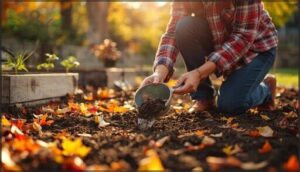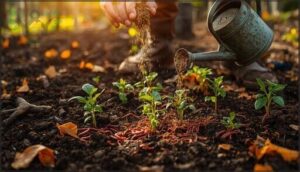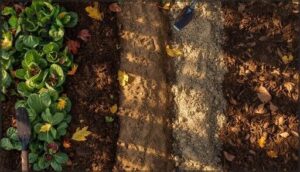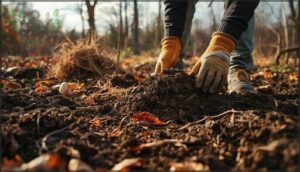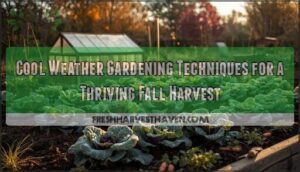This site is supported by our readers. We may earn a commission, at no cost to you, if you purchase through links.
Most gardeners pack up their tools when the leaves start to fall, but autumn is when the real magic happens underground. Add compost now and you’ll boost organic matter by up to 40%—that’s a major advantage for moisture and structure when spring rolls around. Earthworms get busy, cover crops lock in nutrients, and your beds become a buffet for next season’s roots.
Preparing soil for fall planting isn’t just smart—it’s how you set the stage for healthy, thriving crops all year long. Let’s dig into the steps that turn tired summer ground into a powerhouse for autumn and beyond.
Table Of Contents
- Key Takeaways
- Why Prepare Soil in Fall
- Test Your Soil Before You Start
- Add Organic Matter and Amendments
- Choose The Right Tilling Method
- Apply Mulch and Cover Crops
- Water and Settle Your Amended Soil
- Prepare Beds for Specific Fall Crops
- Maintain Soil Health Through Winter
- Frequently Asked Questions (FAQs)
- Should I add anything to my garden soil in the fall?
- What is best to put on soil before planting?
- How do I transition my garden from summer to fall?
- What to add to soil for fall planting?
- When should you start preparing a garden for fall?
- How deep should soil amendments be incorporated?
- Can wet soil be safely worked in fall?
- What tools work best for soil preparation?
- Should different vegetables require different soil preparations?
- How long before planting should soil be prepared?
- Conclusion
Key Takeaways
- Adding compost and organic matter in fall boosts soil structure, moisture retention, and sets up strong root growth for spring.
- Soil testing before amending helps you balance nutrients and pH, preventing problems like poor yields or nutrient loss.
- Cover crops and mulch protect soil from erosion, lock in nutrients, and improve microbial activity through winter.
- Choosing the right tilling method and depth keeps soil loose for root crops, while careful amendment timing avoids compaction and nutrient overload.
Why Prepare Soil in Fall
Fall isn’t just about cleaning up the garden—it’s when you set the stage for next year’s success. Preparing your soil now gives you a head start that spring gardeners can only dream about.
Preparing your soil in fall sets the stage for a thriving garden next spring, giving you a head start over waiting until spring
Let’s look at why fall preparation is worth the effort and how it pays off when growing season arrives.
Benefits of Fall Soil Preparation
When you invest in fall soil preparation, you’re setting yourself up for real rewards. Organic matter added now increases by 20–40%, improving moisture retention and soil structure. You’ll also see earthworm activity jump by 15–25%, boosting nutrient cycling naturally.
Cover crops contribute biomass that cuts erosion and enriches your soil by 2–3 percentage points come spring. Fall planting starts with healthy, well-fed soil.
Understanding the impact of environmental factors, such as water fluoridation effects, can also inform your approach to soil preparation and overall garden health.
Optimal Timing for Soil Amendment
Timing your fall preparation makes all the difference. Apply amendments 4–8 weeks before cold weather hits so microbial activity can work its magic. In clay soil, incorporate organic matter 6–8 weeks early to improve drainage. Staggered amendments work well—add phosphorus and potassium first, then micronutrients later. Green manure seeded in late summer sets you up with soil-ready beds by fall planting time.
Understanding social and political issues can inform your approach to sustainable gardening practices.
Replenishing Nutrients After Summer Crops
Summer crops pull nutrients from your soil, leaving it hungry for the next round. Here’s how to restore what’s been lost:
- Layer 2–3 inches of compost to supply over 50 nutrients your soil needs
- Spread well-aged manure for 2–3 times more nitrogen than fresh alternatives
- Plant cover crops like winter rye to fix up to 150 pounds of nitrogen per acre
- Reduce winter nutrient loss by 35% with organic amendments
Smart crop rotation and microbial balance keep soil fertility strong.
Test Your Soil Before You Start
Testing your soil is the smartest first step you can take before making any amendments. Fall is actually the perfect time to do this, giving you plenty of room to adjust pH and nutrient levels before spring planting rolls around.
Let’s walk through when to test, what those numbers mean, and how to fix what’s off balance.
When and How to Conduct Soil Tests
You’ll want to collect your soil test about 6–8 weeks before your first frost. Grab samples from 6–8 spots across every 1,000 square feet, mixing them into one composite sample—this prevents misleading hotspots.
Your local extension service or lab will interpret test results, flagging nutrient deficiencies and pH imbalance that undermine fall garden preparation.
Good sampling best practices now mean smarter amendment timing and healthier soil later.
Understanding PH and Nutrient Levels
Your soil test reveals pH balance and nutrient cycling patterns that shape soil fertility. Here’s what the numbers mean:
- Nitrogen, phosphorus, and potassium (macronutrients) drive growth—pH imbalance reduces availability by 30–50%
- Micronutrients like iron appear deficient in high-pH soils
- pH 6.0–7.0 suits most vegetables, optimizing nutrient uptake
- Exchangeable cations (Ca, Mg, K) indicate amendment needs
Decode these results before adjusting anything.
Adjusting PH With Lime or Sulfur
Once your soil test pinpoints pH imbalances, you can correct them with targeted soil amendment. Lime application raises pH in acidic soils—spread 40 to 120 pounds of ground limestone per 1,000 square feet, depending on current readings. Sulfur usage lowers pH in alkaline conditions.
Both amendments need time for pH balancing, so fall soil preparation ensures lime effectiveness before spring fertilization and prime soil health.
Add Organic Matter and Amendments
Once you know what your soil needs, it’s time to feed it. Organic matter is the backbone of healthy soil, and fall gives it plenty of time to break down before planting season.
Here’s how to choose and apply the right amendments without overdoing it.
Using Compost and Well-Aged Manure
Compost maturity and manure aging make all the difference in fall gardening. You’ll want mature compost that’s earthy and crumbly, not steamy or stinky.
Well-aged manure delivers 20–40 pounds of nitrogen per 1,000 square feet while improving garden soil structure.
Work these amendments 6–8 inches deep into your soil preparation routine—deeper incorporation boosts microbial activity and can increase yields by 5–12%.
Incorporating Shredded Leaves and Grass Clippings
Those bags of autumn leaves and grass clippings aren’t yard waste—they’re gold for your fall gardening. When you mix shredded leaves with grass clippings, you’ll reduce immobilization by 20% and boost soil moisture retention beautifully.
Here’s what these materials deliver:
- Soil amendment that increases organic matter by up to 30% in one season
- Nitrogen contribution of 1–2% from grass clippings
- Improved leaf decomposition rates when materials are properly shredded
- Better soil preparation through 1–3 inch application layers
- Enhanced gardening practices used by 68% of experienced fall gardeners
Choosing Earthworm Castings and Natural Fertilizers
Earthworm castings work like tiny nutrient factories, releasing 0.5–1.5% nitrogen steadily without burn risk. You’ll boost soil microbes by up to 40% and raise organic matter over time. Apply 1–4 cups per square foot for best results.
Natural fertilizers like compost tea (diluted 1:10) deliver phosphorus and potassium gently, improving seedling survival by 5–12% while supporting stronger roots throughout your fall garden.
Avoiding Over-Amending and Nutrient Imbalance
More isn’t always better when it comes to soil amendment. Piling on compost and manure together can push nitrogen above safe limits, leading to losses within weeks.
A soil test keeps you honest—excessive phosphorus above 80 mg/kg can drop yields by 15% in leafy greens.
Balance nutrients carefully to protect soil health and support smart nutrient cycling for your fall crops.
Choose The Right Tilling Method
Tilling gets mixed reviews in gardening circles, and for good reason—it can help or hurt your soil depending on how you do it. The key is choosing a method that fits your garden’s size and current condition without causing more damage than good.
Here’s how to decide what works best for your fall prep.
Benefits and Drawbacks of Tilling
When you’re weighing whether to till, you’ll want to know the trade-offs. Light tilling can boost organic incorporation and improve soil structure—60% of studies show better results compared to no-till in temperate climates.
But repeated deep tillage can cause carbon loss, increase weed germination by 28%, and trigger tillage erosion on slopes.
A soil test helps you decide what your garden soil preparation really needs.
Hand-Digging for Small Gardens
If your garden is on the smaller side, skip the tiller and grab your digging tools instead. Hand-digging for soil aeration cuts compaction by up to 20% and protects earthworms that keep your garden soil healthy.
Here’s how to tackle manual tilling for fall gardening tasks:
- Loosen soil 8–12 inches deep for root crops
- Work in compost as you dig
- Break clumps gently to preserve soil structure
- Use ergonomic forks to reduce fatigue
- Schedule 1.5–3 hours per 100 square feet
This soil conditioning approach improves garden soil preparation without the machinery.
Light Tilling Techniques for Larger Areas
For plots beyond 500 square feet, light tilling with power tillers or rototillers cuts labor time by 60% while increasing soil aeration by 20%. Choose tractor-mounted tillers with adjustable depth settings to boost microbial activity by 25% and reduce erosion rates by 30%. This approach facilitates fall planting goals—improved crop yields up to 12% and better carbon sequestration—without the environmental impact of deep plowing.
| Equipment Options | Tilling Benefits | Microbial Activity |
|---|---|---|
| Power tillers | 20% better aeration | 25% biomass increase |
| Rototillers | 60% time savings | 30% diversity boost |
| Tractor-mounted units | 15% less compaction | 18% N-fixation gain |
| Sub-soiling implements | 30% erosion reduction | Preserves fungal networks |
| Variable speed tillers | 12% yield improvement | Maintains organic matter |
Minimizing Soil Disruption and Erosion
After tilling, surface mulching and zero-till practices become your best allies for soil conservation. Ground cover with cover crops reduces erosion by 30–70% and lowers soil temperature swings by up to 4°C, boosting organic matter retention.
Rainfall simulation studies confirm that minimal soil disruption cuts annual soil loss in half, protecting soil health while keeping nutrients where your fall plants need them most.
Apply Mulch and Cover Crops
Once you’ve worked amendments into your soil, it’s time to protect what you’ve built. Mulch and cover crops act like a winter blanket, keeping weeds down and locking in moisture while feeding the soil beneath.
Let’s look at how each option works to keep your beds healthy through the cold months.
Using Mulch to Prevent Erosion
Bare soil exposed to fall rains can wash away fast. Mulch types like straw or wood chips act as organic barriers, cutting soil erosion by up to 60% on slopes.
Apply 2–3 inches of straw to slow runoff, or use 3–5 inches of coarse wood chips for winter protection and soil stabilization.
These layers improve water infiltration while adding organic matter that breaks down into compost over time.
Selecting Cover Crops for Nitrogen Fixation
Legume cover crops like hairy vetch or red clover fix nitrogen naturally, enriching your soil with 40–120 kg N/ha per season. These green manure options boost soil microbes and improve soil health through nitrogen fixation, preparing beds for spring crop rotation.
Choose inoculated seeds for stronger nodulation and better legume benefits. This natural soil conditioning reduces fertilizer needs while building long-term fertility—a win for sustainable gardening.
Winter Rye, Annual Ryegrass, and Field Beans
These three powerhouse cover crops offer unique strengths for fall soil conditioning. Winter rye excels at erosion control while ryegrass delivers fast green manure benefits. Field beans bring nitrogen fixation into your crop rotation strategies, naturally enriching soil for spring planting.
- Winter rye cuts erosion by up to 60% and produces impressive biomass by spring
- Annual ryegrass establishes quickly, covering ground in just 14–28 days
- Field beans fix 60–120 kg nitrogen per hectare as a winter legume
- Combined plantings boost soil health improvement and weed suppression together
How Cover Crops Improve Soil Structure
Cover crops work like tiny underground architects—their root penetration breaks up compacted layers while promoting soil aggregation. Aggregate stability increases up to 40%, and decomposing residues boost humus content steadily.
You’ll see moisture retention jump 15–20% as roots create channels that hold water. These soil conservation strategies deliver lasting soil health improvement through natural soil conditioning that transforms tired beds into thriving ecosystems.
Water and Settle Your Amended Soil
After you’ve amended your soil, it’s tempting to step back and call it done. But watering your garden beds now does more than you might think—it helps everything settle in and start working together.
Let’s walk through why this step matters and how to do it right.
Why Watering After Amendment Matters
Watering after amending your soil does more than just add moisture—it kicks off nutrient activation and boosts microbial activity right where you need it. Moisture helps with soil incorporation, allowing organic matter and compost to settle evenly while preventing erosion.
This step aids settling amendments, improves soil health, and strengthens your overall soil management strategy. Think of it as waking up your fall beds.
Proper Watering Techniques for Fall Beds
Think of fall watering like a gentle handshake—firm but not crushing. You’ll want to keep soil moisture around 60-70% of field capacity, watering when the top inch or two feels dry.
Drip irrigation cuts water waste by up to 50% compared to sprinklers, delivering moisture right where roots need it. Morning watering paired with 2-3 inches of mulch maximizes water infiltration while reducing evaporation, making your soil management and fall garden preparation more efficient.
Preventing Soil Compaction and Erosion
As moisture sinks in, it’s time to guard that hard-earned soil health. Heavy foot traffic or leaving soil bare creates the perfect storm for compaction, tamping down roots and robbing air pockets.
Apply compost generously and keep beds covered—mulch or a living cover crop layers on soil stabilization and erosion control, giving your fall beds a fighting chance at winter’s doorstep.
Prepare Beds for Specific Fall Crops
Every fall crop has a few quirks regarding the soil it likes best. Let’s look at what gives each one a strong start.
Here’s what you’ll want to know before planting.
Soil Requirements for Leafy Greens and Spinach
For a bed full of leafy greens or spinach, pay close attention to soil basics. Aim for a preferred pH between 6.0–7.0, steady nitrogen levels, and loose soil that drains well. Consistent organic matter from compost boosts growth. Here’s what matters:
- Preferred pH: 6.0–7.0
- Nitrogen Levels: 40–60 ppm
- Soil Drainage: never soggy
- Temperature Range: 55–75°F
Preparing Loose Soil for Carrots and Root Vegetables
Loose, airy soil pays off with stronger root depth and better carrot yield. Aim for a bed that crumbles in your hands—think high organic matter and well-worked compost for best soil aeration and easy nutrient uptake.
Address soil compaction early with hand tools or amendments; soil health improvement this season sets your root vegetables up to thrive.
PH and Drainage Needs for Garlic and Onions
A great carrot harvest starts with loose, workable ground—just as garlic and onions thrive on well-managed Soil pH Management and Drainage Systems. Before fall cropping, run a soil test and fine-tune pH between 6.0 and 7.0.
Mix in compost for stable Garlic Nutrition and healthier bulbs. Keep water moving with soil conditioning and conservation techniques to reduce bulb rot risk.
Supporting Peas, Kale, and Brassicas
For a thriving fall patch, pay close attention to Soil Health with generous layers of organic matter and Compost. Peas love soil rich in microbes and don’t need much extra nitrogen thanks to natural fixation, helping future Brassica Care.
Keep soil loose for kale nutrition, apply targeted amendments, and water deeply. Balanced fall fertilizers and conditioning protect against Pea Diseases.
Maintain Soil Health Through Winter
Caring for your soil doesn’t stop once the weather turns cold. A few smart steps now will help your beds stay healthy, so they’re in top shape come spring. Here’s what to look out for as winter settles in.
Protecting Beds From Winter Erosion
Did you know winter storms can strip away 20–30% of your topsoil if you leave ground bare? That’s why soil erosion prevention is key: mulch selection, installing straw or wood chips, and using well-designed structural barriers all protect soil health.
Smart bed design means less wind damage, while ongoing soil care and maintenance weave resilience through your winter soil conservation strategies.
Monitoring Moisture and Drainage
How do you keep winter soil in peak shape? Watch Water Dynamics closely: this means blending practical Soil Science with simple habits. Check these off:
- Use mulch to slow evaporation and balance moisture.
- Probe Garden Soil for drainage after heavy rains—poor Drainage Systems risk waterlogging roots.
- Adjust fall Irrigation Plans so beds aren’t soaked or parched.
Attentive Soil Care and Maintenance now makes for stronger spring growth.
Planning Spring Planting Schedules
Picture your spring garden thriving—here’s the secret: Plan ahead with a weather-adjusted calendar and mark your region’s frost date impact. Aim for soil temperature targets of 50–60°F before you plant, and run pre-plant soil tests for precise amendments.
Uniform bed yields come from smart soil conditioning and steady soil care and maintenance all winter.
Ongoing Soil Care Practices
Does your soil get pampered in winter, too? Autumn soil tests set the stage, guiding everything from compost to pH tweaks. Aim for aggregate soil stability by skipping deep tilling. Cover crop timing matters—sow winter rye early to cut erosion. Continuous mulching with organic matter keeps moisture in check. Think of these habits as weaving a blanket for your garden’s roots.
- Test and tweak soil each fall.
- Favor light tilling or hand-digging.
- Plant winter rye before frost.
- Protect beds with continuous mulching.
- Monitor drainage and adjust as needed.
Frequently Asked Questions (FAQs)
Should I add anything to my garden soil in the fall?
Funny how autumn’s chill lines up perfectly with the best Amendment Timing.
Yes, you should add Organic Matter—like Compost or shredded leaves—in fall. This boosts Soil Carbon, Microbial Activity, and keeps Nitrogen Balance in check.
Soil test first!
What is best to put on soil before planting?
Before planting, layer finished compost to boost organic matter, add well-aged manure for a nitrogen lift, and apply lime if pH needs adjusting.
Cover crops enrich soil, while mulch types like straw or wood chips protect amendments and prevent erosion.
How do I transition my garden from summer to fall?
Sweeping out spent summer crops, tidying with focused garden cleanup tasks, shifting to cooler soil methods, plugging in fall pest control, and planning new beds—all play a part in garden preparation, soil conservation, and sustainable gardening for fall.
What to add to soil for fall planting?
You’ll want to work in organic matter like compost or manure, sprinkle in natural fertilizers, and add leaf mold for steady benefits.
Try cover crop mixes, watch your soil amendment rates, and boost nutrition before winter’s rest.
When should you start preparing a garden for fall?
Picture a gardener checking their frost dates in early September—this is the sweet spot.
For best Garden Readiness, start Autumn Planning 4–6 weeks before the first hard frost, when Soil Temperatures remain workable for adding Organic Matter and Amendments.
How deep should soil amendments be incorporated?
For most gardens, aim for an incorporation depth of 6 inches with organic matter or compost. Heavy clay benefits from deeper amendment mixing—up to 12 inches—while sandy or loam soil responds well to even soil layering and careful tilling methods.
Can wet soil be safely worked in fall?
Think of wet soil as a sponge—squeeze too soon, and you risk compaction and clumping. Wet soil risks include poor root growth and erosion.
Moisture monitoring and tilling alternatives help protect structure, supporting soil conservation and better amendment timing.
What tools work best for soil preparation?
Hand tools like soil knives and broadforks offer precision and conserve soil structure. Power tillers and garden tillers suit larger areas but require careful use.
Specialized equipment helps with garden soil management, tilling, and applying fertilizers for effective soil conservation strategies.
Should different vegetables require different soil preparations?
Leafy greens thrive with higher nitrogen and pH optimization, while root crops like carrots demand loose soil texture for better root development.
Crop-specific needs shape garden soil management, from organic matter to fertilization, ensuring nutrient availability and balanced plant nutrition.
How long before planting should soil be prepared?
You’ll want to prepare your soil about 4–6 weeks before planting. This timing allows Amendment Integration, boosts Microbial Activity, and benefits from warmer Soil Temperature Impact—especially before Frost Considerations kick in.
Mulch Timing helps with Soil Conservation Techniques.
Conclusion
Imagine this: beneath the quiet surface, roots stretch into rich, crumbly earth, fueled by your careful work preparing soil for fall planting. Each step—testing, amending, mulching—sets off a chain reaction below, where microbes and worms build a foundation for spring’s bounty.
You’re not just tending dirt; you’re planting possibility. Trust the process, and as winter settles in, know your garden’s story is already unfolding—hidden, patient, and ready to bloom when the world warms again.
- https://www.pewresearch.org/topics/
- https://mypaperhelp.com/blog/research-paper-topics
- https://digitalcommons.usf.edu/cgi/viewcontent.cgi?article=1002&context=oa_textbooks
- https://stlcc.edu/student-support/academic-success-and-tutoring/writing-center/writing-resources/topic-ideas.aspx
- https://pmc.ncbi.nlm.nih.gov/articles/PMC10807936/


